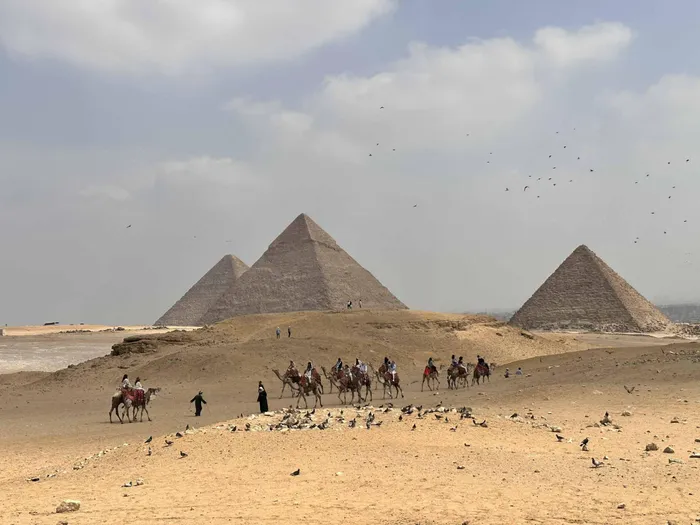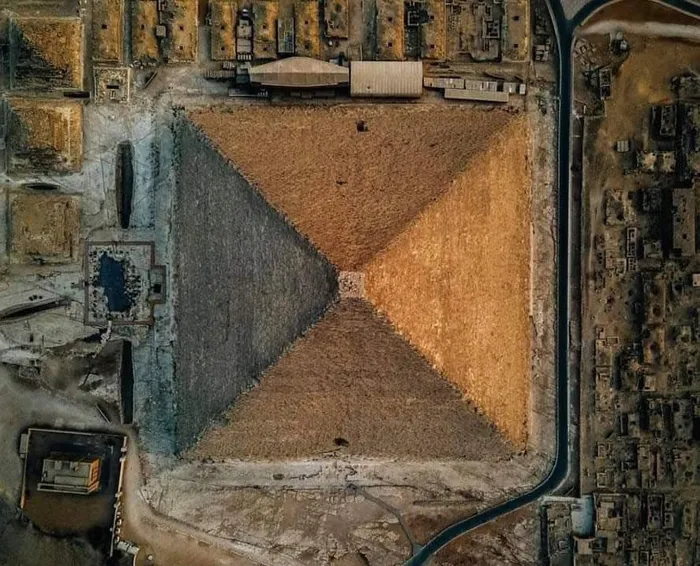The Great Pyramid of Khufu, also known as the Pyramid of Cheops, stands as one of the most awe-inspiring and enduring monuments of ancient Egypt. Constructed during the Fourth Dynasty of Egypt’s Old Kingdom (2589–2566 BC), this colossal structure held the title of the tallest man-made building in the world for over 3,800 years. Reaching a height of 146.5 meters (481 feet) when it was first built, it remains the only surviving member of the original Seven Wonders of the Ancient World, showcasing both the grandeur of its design and the remarkable achievements of ancient Egyptian civilization.
The Design and Structure of the Pyramid
Originally, the Great Pyramid was sheathed in a smooth, polished layer of high-quality Tura limestone. These casing stones were quarried from the region south of Cairo and transported via the Nile River. The smooth, reflective surface of these stones would have given the pyramid a dazzling, almost supernatural appearance, reflecting the sun’s rays and making it visible from great distances. Over time, however, most of the outer casing has been lost, leaving behind the stepped core of the pyramid that we see today.

The pyramid is not just an architectural marvel on the outside. Inside, it contains three main chambers: the subterranean chamber carved into the bedrock beneath the pyramid, the Pharaoh’s Chamber which once housed the sarcophagus of Khufu, and the Queen’s Chamber, whose exact purpose remains unclear. The Pharaoh’s Chamber, in particular, offers a rare and intimate glimpse into the burial practices of ancient Egyptian royalty. Khufu’s sarcophagus, which still resides in this chamber, is a testament to the grandeur and reverence surrounding the Pharaoh’s final resting place.
The Grand Gallery: A Monument to Engineering Genius
One of the most impressive features of the Great Pyramid is the Grand Gallery, an enormous corbelled passageway that leads up to the Pharaoh’s Chamber. This architectural feat exemplifies the advanced engineering capabilities of the ancient Egyptians. The gallery’s design helps distribute the immense weight of the pyramid above, showcasing the precision and ingenuity of its creators. The sheer size and scale of the pyramid are astonishing: over 2.3 million limestone blocks were used in its construction, each weighing several tons. Some of the heavier blocks, particularly those used in the burial chambers, are thought to have been transported from quarries as far away as Aswan, located several hundred kilometers to the south.

The Mystery of Construction Techniques
Despite numerous theories, the exact methods used to construct the Great Pyramid remain one of the most debated subjects in archaeology. Scholars have proposed various models, including the use of straight, zig-zagging, or spiral ramps to transport the massive stones, but no conclusive evidence has been found to confirm any of these theories. Some have even suggested the possibility of advanced cranes or machinery, though the lack of concrete evidence means these ideas remain speculative. The scale of the pyramid’s construction likely involved thousands of laborers and artisans working over a period of 10 to 20 years, but how they managed to achieve such precision and scale with the tools available at the time remains a captivating mystery.
The Discovery of the Ships
In addition to the pyramid itself, two large disassembled ships were discovered in pits on the south side of the pyramid. These ships, believed to have been used in the transport of Khufu’s body and burial goods to the tomb, offer insight into the elaborate and symbolic nature of royal burials in ancient Egypt. These vessels, found in a dismantled state, may also have had religious significance, representing the Pharaoh’s journey to the afterlife, which was a central aspect of Egyptian belief.

A Lasting Symbol of Egyptian Mastery
The Great Pyramid of Khufu is not just a monumental tomb, but a lasting symbol of the architectural and engineering mastery of ancient Egypt. Its sheer size, precision, and durability continue to impress scholars and visitors alike. Despite centuries of study, the construction of the pyramid remains an enigma, with theories ranging from practical ramp systems to speculative ideas about advanced technology. What is certain, however, is that the pyramid represents a monumental achievement that still captivates the imagination of the modern world.
The Great Pyramid stands not only as a testament to Egypt’s architectural prowess but also as a symbol of the cultural and technological brilliance of one of history’s most advanced civilizations. Its legacy, as the last remaining wonder of the ancient world, continues to inspire awe and wonder, making it a timeless monument to human ingenuity.

